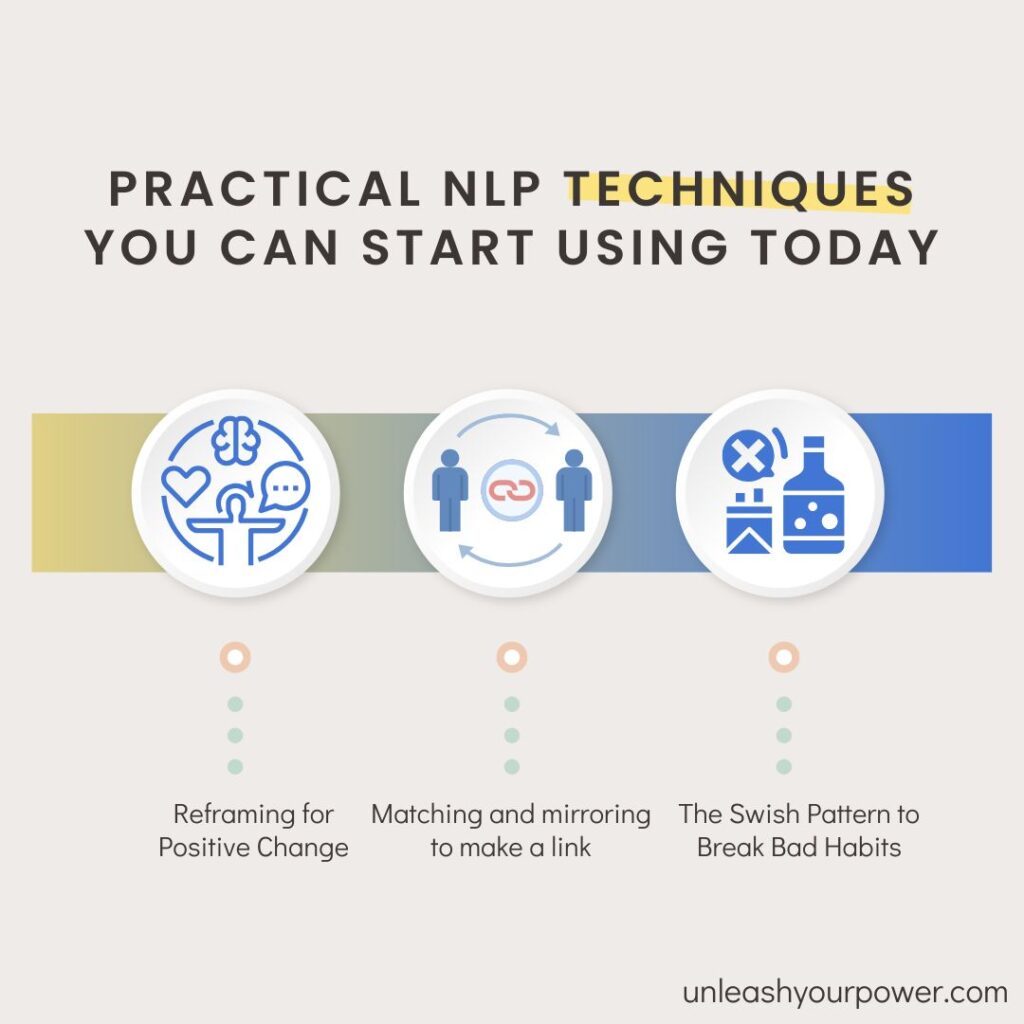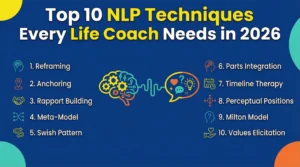Neuro-Linguistic Programming (NLP) is a powerful approach that helps us understand how our thoughts, language, and behaviors influence our interactions with others and ourselves. In simple terms, NLP is like a toolkit for mastering communication, emotional intelligence, and personal growth. By becoming more aware of how we process information and respond to situations, we can change habits, improve relationships, and achieve our goals more effectively.
NLP’s relevance extends beyond personal development—it plays a vital role in professional settings too. Whether you’re a leader looking to inspire your team, a business owner seeking to enhance customer interactions, or simply someone aiming to communicate better in everyday life, NLP offers practical strategies that make a difference.
In this post, you’ll discover actionable NLP techniques to improve communication, manage stress, build stronger relationships, and unlock new opportunities—both personally and professionally. Let’s dive in!
Core NLP Concepts for Beginners

Neuro-Linguistic Programming (NLP) offers practical tools that can transform how you think, communicate, and handle challenges. By understanding how our minds influence our actions, you can unlock new levels of personal and professional growth. Let’s explore three foundational concepts in NLP—ideas that can immediately impact how you approach everyday situations.
The Relationship Between the Mind and Body
Our thoughts and actions are deeply connected. When you repeatedly tell yourself, “I’m not good enough,” it creates doubt and holds you back. But changing that self-talk to something positive—like “I have the skills to succeed”—can shift your entire mindset.
Research published in Psychology of Sport and Exercise shows that athletes who practiced constructive self-talk saw an 11% increase in performance. The same applies to everyday life: what you say to yourself directly influences how you act. Imagine what could change if you consistently spoke to yourself with confidence and positivity.
The Power of Submodalities
Submodalities—such as the vividness of mental images, sound, and tone—shape how we perceive events. Picture a difficult meeting replaying in your mind as a large, clear memory. Now imagine shrinking that image or blurring it—suddenly, it feels less overwhelming.
This subtle shift in perception can significantly reduce stress. By changing the way you mentally represent experiences, you regain control over your emotional responses.
Anchoring
Anchoring connects a positive emotion to a physical action, allowing you to trigger that emotion when needed. For example, I worked with someone who had anxiety about public speaking. By linking confidence to a simple gesture—placing their hand on their heart—they transformed their fear into calm assurance.
The effects were remarkable. They went from feeling nervous to being a confident, engaging speaker. Studies in behavior research and therapy support this method, showing that emotional triggers can be activated even in high stress.
Practical NLP Techniques You Can Start Using Today
Neuro-Linguistic Programming (NLP) offers simple, actionable techniques that create real change. By understanding how language and thoughts influence behavior, you can break limiting beliefs, enhance confidence, and improve relationships.

Reframing for Positive Change
You can see failures in a new way when you reframe them. Didn’t see a promotion? Do not dwell on it; instead, see it as a chance to improve your skills. Or if your boss tells you something negative, see it as helpful information that will help you improve. You can turn problems into possibilities by changing how you see them.
Matching and mirroring to make a link
Mirroring means copying someone else’s tone of voice, body language, and speed of speech without being obvious about it. This technique makes people feel like they have a connection during job interviews. Just make sure to leave it alone. Trust is built without the other person even realizing it when it’s done right.
The Swish Pattern to Break Bad Habits
Want to replace procrastination with productivity? The Swish Pattern can help. Picture the negative behavior (e.g., procrastination), then visualize the positive alternative (e.g., being productive). Mentally shrink the negative image while bringing the positive one closer and brighter.
Repeat until the negative habit loses its hold. I’ve seen this technique turn procrastinators into efficient achievers.
NLP Techniques for Emotional Mastery
NLP (Neuro-Linguistic Programming) enhances emotional mastery by helping individuals understand and influence their emotional responses. By using techniques like anchoring, NLP allows you to recreate positive emotional states in stressful moments. Reframing shifts negative perspectives into more empowering ones, reducing emotional distress. Through methods like the Swish Pattern, NLP replaces unhelpful thought patterns with constructive, positive thinking. Additionally, Parts Integration helps resolve internal conflicts, promoting emotional balance. Overall, NLP equips individuals with tools to control and manage their emotions more effectively, leading to greater emotional resilience and mastery.
Managing Emotional States
Pattern interrupts and deep breathing are NLP methods that help you calm down when you’re stressed. Focus on taking slow, deep breaths and picturing a good state of mind before a big talk. Research from the International Journal of worry Management shows that taking deep breaths can cut worry by 30–40%.
Developing Beliefs That Give You Power
NLP can also assist in altering self-limiting beliefs. One of my clients was never sure they could be a leader. By acknowledging their negative beliefs and swapping them out for empowering statements, individuals transformed their self-perception. They became more self-assured and skilled leaders over time. Research supports this by demonstrating that a person’s self-esteem can increase by 25% by altering their limiting beliefs.
Using NLP Techniques in Interpersonal Settings
Using NLP techniques in interpersonal settings improves communication, rapport, and emotional understanding. Methods like mirroring body language build connection, while reframing shifts perspectives for better understanding in conversations. NLP also enhances active listening and empathy, helping individuals respond more effectively in social interactions. Overall, it promotes clearer communication, trust, and stronger relationships.
Active Listening
Paying Attention Active listening can transform any relationship. When you give someone your full attention, they feel valued and respected. I once helped a business partnership resolve a major conflict by teaching both parties to listen actively. As they started to hear each other truly, their stress faded, and cooperation flourished.
According to research, active listening can improve teamwork and problem-solving by 17%. Imagine how this technique could change your interactions at work or at home.
Time Management & Direction
Managing Time and Direction Another powerful NLP technique is pacing—matching someone’s communication style and emotional state, then gently steering the conversation toward resolution. This is especially helpful in family disputes or heated conversations. I’ve seen arguments transform when one person begins by acknowledging the other’s feelings and tone, then slowly introduces more calming, solution-oriented language. This subtle shift can dissolve tension and lead to a more productive outcome.
Using NLP Techniques in Workplace
Using NLP techniques in the workplace can enhance communication, collaboration, and productivity. NLP helps individuals better understand their own and others’ thought patterns, allowing for more effective interactions. Techniques like rapport-building foster stronger team connections, while reframing helps shift perspectives to resolve conflicts or overcome challenges. Anchoring can also be used to maintain a positive mindset during stressful situations. By improving emotional intelligence and adaptability, NLP techniques create a more harmonious, efficient work environment where employees can communicate clearly and work together more effectively.
Building Influence and Persuasion Skills
In leadership or sales, influence is key. NLP can enhance your persuasive abilities by helping you align your message with the other person’s needs. I worked with a client who was struggling to close a deal.
By using NLP language patterns and focusing on the client’s core needs, they sealed the deal—and saw a 20% boost in their sales effectiveness, according to research from the Journal of Consumer Psychology.
NLP for Leadership
NLP also offers powerful tools for leadership. One of my clients successfully resolved a team conflict using reframing and mirroring techniques. By changing how they communicated and actively listening to their team’s concerns, they fostered collaboration, improving team morale by 15%. Studies show that leaders who adopt NLP strategies see marked improvements in team performance and engagement.
How to Overcome Common Obstacles When Implementing NLP

Staying Consistent Change doesn’t happen overnight, and forming a new habit takes about 66 days, according to studies. Sticking with NLP is easier when you incorporate small techniques into your daily routine. Whether it’s practicing positive self-talk in the morning or using the Swish Pattern to break a negative thought loop, these small, consistent actions lead to long-term transformation.
Getting Past Self-Doubt
If you’re feeling uncertain about NLP’s effectiveness, start small. Research shows that 87% of participants who used NLP reported increased emotional resilience. Begin with straightforward strategies like anchoring, where you connect a positive emotion to a simple action, or reframing, which helps you see situations from a new perspective. These small wins build your confidence over time.
Shaking off old habits
Breaking old habits can be challenging, but repetition is key. The more you practice NLP techniques, like the Swish Pattern—where you replace an unwanted behavior with a more positive one—the easier it becomes to adopt new, constructive behaviors. Remember, it’s about rewiring your mental pathways one step at a time.
Maintaining Simplicity
It’s easy to get overwhelmed by trying too many techniques at once. Instead, start with just one or two, such as reframing or active listening. By focusing on small, manageable improvements, you’re more likely to see lasting results. Slow, steady progress is the key to mastering NLP.
Dealing with Setbacks
Progress isn’t always linear, and setbacks are part of any personal growth journey. It’s easy to get discouraged when things don’t go as planned, but NLP teaches resilience. When facing setbacks, use techniques like future pacing, where you visualize a successful outcome and the steps you need to take to get there. This helps you reframe challenges as temporary and motivates you to keep pushing forward. Remember, setbacks are opportunities to learn and adjust your approach.
Managing Expectations
One common obstacle is expecting immediate results, but real change takes time. NLP is about gradual shifts in mindset and behavior, not quick fixes. To manage expectations, set realistic, measurable goals for yourself. Break down your desired outcomes into small, achievable steps. For example, instead of aiming to completely eliminate a limiting belief overnight, focus on making incremental shifts in how you think about it. By celebrating these small milestones, you’ll stay motivated and on track toward long-term success.
Final Thought: Begin Your NLP Adventure Now
NLP provides useful, user-friendly tools to enhance relationships, advance personal development, and improve communication. NLP approaches can bring about long-lasting, beneficial changes in your life, from rephrasing negative beliefs to establishing rapport.
Are you prepared to learn more? To learn more about how NLP can benefit you, schedule a private session or enroll in our Advanced NLP Training & Certification.
FAQs
In what ways does NLP support stress management in daily life?
NLP offers useful stress-reduction strategies, including anchoring happy emotions and rephrasing negative beliefs. You can improve your ability to manage your reactions and lessen stress by altering the way you see stressful situations.
Can NLP enhance interpersonal and professional communication?
Yes, by fostering rapport and trust, NLP techniques like mirroring and active listening improve communication. These methods help you build stronger connections and gain a deeper understanding of other people’s viewpoints, which is advantageous in both personal and professional contexts like teamwork and negotiating.
How may the Swish Pattern assist in breaking negative habits?
An NLP method called the Swish Pattern can assist in changing negative habits into constructive ones. You can gradually lessen the power of a negative habit by mentally “swishing” the images by envisioning the habit and comparing it with a favorable consequence.
How might NLP strategies like anchoring increase self-assurance?
Anchoring establishes a connection between a particular behavior (such as putting your hand to your heart) and a favorable emotional state (like confidence). This anchor may be set up and used whenever necessary, which makes it a useful tool for enhancing confidence in high-stress scenarios like job interviews or public speaking.





